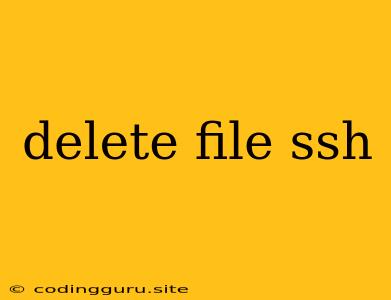Deleting SSH Files: A Guide to Securely Removing Your SSH Keys
SSH, or Secure Shell, is a protocol that enables secure communication over an unsecured network, most commonly used for remote login and file transfer. Your SSH keys are vital for authenticating with remote servers. They are like digital fingerprints, allowing you to access your servers without having to type in a password each time. While you may need to keep certain SSH keys for ongoing access, there are instances where deleting them is crucial for security and system maintenance.
Why Would You Need to Delete SSH Files?
There are several reasons why you might want to delete your SSH files:
- Compromised Key: If your SSH key has been compromised, deleting it is critical to prevent unauthorized access to your servers. This could happen if your computer was infected with malware or if you suspect that someone has gained access to your private key.
- No Longer Needed: If you are no longer using a particular server or service, you can safely delete the associated SSH keys. This helps to keep your system clean and organized, and reduces the risk of accidental misuse.
- Changing Servers: When switching to a new server or service, you may need to generate new SSH keys for security reasons. Deleting the old keys is a good practice to ensure that only the new keys are being used.
- Revoking Access: If you want to revoke someone's access to your servers, deleting the associated SSH key is an effective way to do so. This can be done if an employee leaves your company or if you need to restrict access for security purposes.
How to Delete SSH Files
The exact steps for deleting SSH files will vary slightly depending on your operating system, but the general process is similar.
1. Locate Your SSH Files:
- Linux and macOS: SSH keys are typically located in your home directory under the
.sshfolder. You can find it by opening your terminal and typingcd ~/.ssh. - Windows: On Windows, SSH keys are often stored in the
C:\Users\<username>\.sshdirectory.
2. Identify the Key to Delete:
- Key File Names: Your SSH keys are typically named
id_rsa(for private keys) andid_rsa.pub(for public keys). If you have multiple keys, they might have names likeid_rsa_workorid_rsa_githubto differentiate them. - Examine Key Contents: You can open the
id_rsafile in a text editor to verify that it is the correct key before deleting it.
3. Delete the Key:
Once you have identified the correct file, use the rm command in your terminal to delete it. For example, to delete the private key id_rsa, you would run the following command:
rm id_rsa
To delete the public key, you would use:
rm id_rsa.pub
Important Note: Deleting your private key will revoke access to any servers that use that key for authentication. Make sure you have backup access to your server if you're deleting your primary key.
4. Remove the Key from Your SSH Agent:
After deleting the key, you may need to remove it from your SSH agent. This is a system service that stores your SSH keys in memory, allowing you to use them without needing to re-enter your password each time.
You can remove a key from your SSH agent using the following command (replace id_rsa with the name of your key):
ssh-add -d id_rsa
Security Considerations
- Careful Deletion: Always double-check that you are deleting the correct SSH key before executing the
rmcommand. Deleting the wrong key can lead to the loss of access to important servers. - Backup: It's a good idea to back up your SSH keys before deleting them. This will ensure that you can easily restore them if necessary. You can use a cloud storage service, external hard drive, or other secure method to store your backups.
- Regular Security Checks: Make sure you periodically review your SSH keys and remove any that you no longer need. This will help to keep your system secure and minimize the risk of unauthorized access.
Alternatives to Deletion
- Disable the Key: Instead of deleting your key, you can disable it by editing the
authorized_keysfile on the server. This file contains a list of public keys that are allowed to access the server. You can comment out the line that corresponds to the key you want to disable. - Generate a New Key: If you need to restrict access to your server, you can generate a new SSH key with more limited permissions. You can then distribute this new key to specific users or systems.
Conclusion
Deleting SSH files is an essential step in maintaining the security of your servers. By understanding the reasons behind deleting your SSH keys and the proper steps to remove them, you can ensure that your system remains secure. Always remember to prioritize security and follow best practices when dealing with SSH keys.
